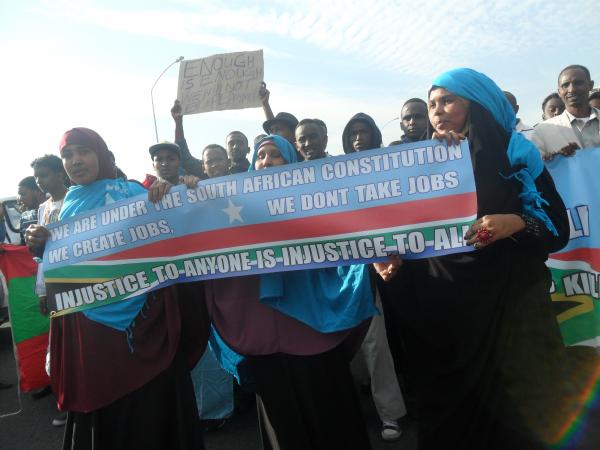

Somalis march against xenophobia on 7 June 2013. Photo by Tariro Washinyira.
21 April 2015
Much has been written about why the recent wave of xenophobic attacks took place. But it’s more complex than the usual reasons given, argue the authors.
Broadly speaking, one can group the various explanations into three categories. The first is King Goodwill Zwelithini’s problematic speech during a “moral regeneration” event. The second argument points to the country’s dire economic situation and outlook as well as widespread poverty and inequality. A third explanation invokes South Africa’s violent past and the opportunistic and sporadic actions of criminals as the reasons for the killing of human beings and the destruction of property. If all this is true, these factors should not only be present in areas where the xenophobic attacks took place; they should also be absent in areas where there has not been such violence.
Otherwise we will be missing important contributing factors that caused the latest upsurge in xenophobic violence. All we will have done is recognise symptoms, leaving root causes undetected and untreated.
In this article we draw on academic as well as news articles relating to South Africa (and Germany where applicable) to point to three analytical shortcomings of the above approaches that might limit their usefulness.
First, let us have a closer look at the economic structure argument. The assumption that once we bolster growth and stabilise the economy, wealth redistribution will increase, thereby diminishing the impetus for attacks, may be unwarranted. For example, despite Germany’s much better economic track record (the unemployment rate fell to its lowest in more than 20 years in March) and lower levels of inequality, the country nevertheless witnessed a drastic intensification of violent attacks on homes of asylum seekers during the past years, from 24 incidents in 2012 to 150 in 2014.
And if we look at where the 2008 attacks in South Africa occurred, we must be careful not to fall prey to reductionism. Wits University’s Forced Migration Studies Programme found that these attacks typically occurred in places with high levels of economic deprivation, high percentages of male residents, high levels of informal housing, and high levels of language diversity (including many South African and foreign languages). Yet, these areas also often had relatively low percentages of residents in the lowest income brackets.
Moreover, the attacks did not occur in places with the highest rates of unemployment, the highest percentage of residents with low education, or the highest percentage of foreign residents.
Thus, although the study does not completely deny a relationship between levels of economic deprivation and the occurrence of attacks, it also points to a more complex set of factors.
The second analytical shortcoming we would like to point out pertains to the theory of violence and criminal elements. All too often, authors selectively refer to South Africa’s violent soul and inability to find other avenues to resolve issues. Yet, limiting our descriptions of townships to generic places of crime and social and economic deprivation, prevents us from appreciating the complexities of intercultural marriages and community efforts to curb crime and xenophobic violence.
Instead of focusing only on the mix of factors in so called ‘hot-spots’ we should also explore the motivation behind entire communities, characteristically not much different to the attack sites, uniting under the anti-xenophobia banner.
A point of departure might be to keep the long overdue promise to see people for who they are and what they do, and not for what they (don’t) have or where they live.
The third criticism concerns the destructive pitting of South Africans and foreigners against each other. The accusation that foreigners crowd out locally owned spaza shops is only one example of a widely-held belief that foreigners take economic opportunities away from South Africans.
Accounts of how foreign migrants contribute to the economy and create jobs are few and far between, though these success stories are not uncommon. In their Johannesburg study, the International Migration Research Centre in cooperation with researchers from South African universities found that foreign informal operators were twice as likely as South Africans to employ people. What is more, four in every 10 employees in the foreign-owned businesses interviewed in a UCT study in Cape Town and Johannesburg were South African.
Thus, the uncritical repetition of stereotypes about foreign informal traders not only drives a wedge between them and others who face similar hardships, but also prevents us from thinking about the country’s economy in ways that do not require foreigners to leave for South Africans to win.
Instead of accepting easy answers and turning to destructive stereotypes, we should focus on the richness and complexity of people’s daily interactions. This is an opportunity to recast the debate beyond the refrain of ‘porous borders’ and to examine the very deficient attempts at integration by the State. It is also a call to broaden our horizon and have honest conversations with people we often see as part of the problem, when in fact they are part of the solution.
Matthias Krönke is an MA candidate in the Political Studies Department at UCT. Mpho Raboeane is a Bcom PPE and post-grad LLB from UCT. Views expressed do not necessarily reflect those of GroundUp.